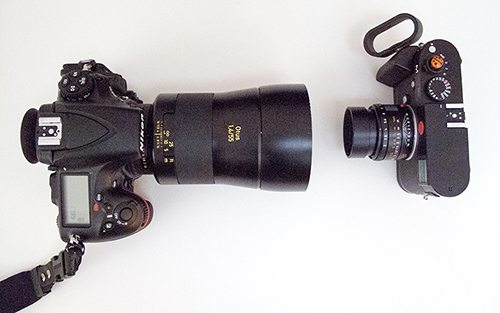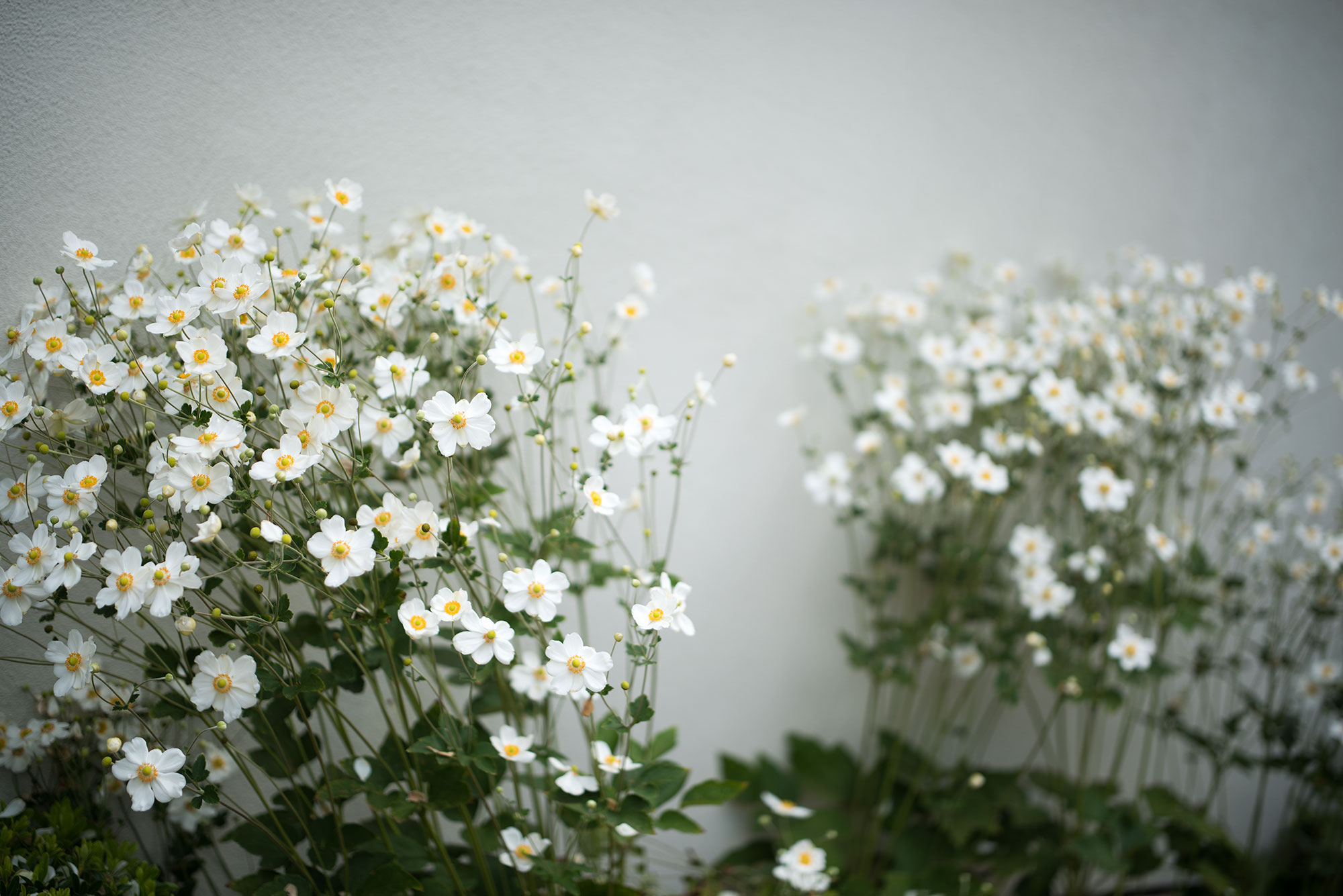Introduction
For my high quality work I always prefer formats larger than 35 mm. However, sometimes I do utilize 35 mm equipment when circumstances dictate that it is the proper choice. Most of the time I use a Leica M 240. I like its compact size, simplicity, extremely high quality lenses and deadly accurate rangefinder focusing.
I was however curious to try out the highly touted Nikon D 810 with the Zeiss Otus 55 mm F/1.4 lens.
A few words about 35 mm DSLR’s
In general, I do not like 35 mm DSLR’s. I find them to be heavy, clunky, terrible in terms of ergonomics; overly complicated and peppered with too many buttons, many of them in the wrong places. I find the displays and the menus massively frustrating and very badly designed.
To me, current 35 mm DSLR’s are a classic example of what happens when a manufacturer tries to cram every possible feature and function into a device that is supposed to work as a “one size fits all” solution for every conceivable application. While this may lead to manufacturing, logistics and other efficiencies, the result is a highly overdone, overly complicated, unergonomic, heavy, big monster with a myriad of functions and configurations.
Most users will only need a small fraction of what is embedded in the device. Furthermore, much of the hardware can be useless for many users; for example, a landscape photographer does not need a super-fast motor drive so the extra weight of the motor and batteries are a real drawback.
The new Nikon D 810 is typical of the class. Just when I thought instruction manuals and configuration menus could not get any worse, here comes a camera with a user manual that exceeds 500 pages (!). The menus are even worse than the prior D 800/800E cameras. With the D 810 user manual and menus, Nikon has reached a new low…
First impressions
It takes several hours to understand the D 810 and to configure it for basic high image quality photography. I had lots of experience with a D 800E and it still took me a couple of hours to figure out the main differences and to configure the camera.
One of the things that truly boggles my mind are the factory defaults for Japanese cameras in general and for the D 810 in particular: Here is a machine that is sold mostly to professionals and advanced enthusiasts. Nikon touts its image quality and the high Megapixel count (for 35mm) of this camera, and yet, all the factory defaults are set for basically the lowest possible quality images. And make no mistake, the camera will fight you every step of the way as it wants to shoot low resolution JPEGs in sRGB color space, save to the slower SD card, etc. Ridiculous! The default settings for shooting mode, metering, button preferences, autofocus, etc. are also not geared towards high quality images.
There are so many functions and options in this camera, that some of the most critical functions for experienced photographers are hidden in arcane places in the menus and weird button commands are often required. Example: In Live View mode you have to push the lower “Info” button twice to show the levels tool on the screen. In case you are wondering, yes, there are two buttons labeled “info”, which is not smart design to begin with!
It is no wonder that many photographers carry the manual with them and sometimes miss priceless shots as it is almost impossible to remember all these arcane things. Ah, but I forgot to mention that the manual is so badly written and so badly organized that it is extremely difficult to locate these things in the manual and some features and functions are not even in the manual at all.
Having said all that, the D 810 is a significant improvement over the D 800E.
Just like the D 800E, the D 810 is a widely misunderstood camera. Let me elaborate:
I have read endless reports, sales ads, user opinions and professional reviews claiming that the D 800E has no low pass filter. This is simply false.
The D 800E has two bi-refringent elements that Nikon uses as low pass filters. They are configured so that one is supposed to cancel the effects of the other, but as we all know, nothing is perfect. Therefore, there are some residual effects present. Add to this the effect of light having to go through the two bi-refringent elements with their 4 surface to air interfaces (which also degrades image quality) and what you have is something that is better than the D 800 (where the two birefringent elements are configured as horizontal and vertical low pass filters), but not as good as a camera with no filters at all.
I say that the D 810 is widely misunderstood because again, I have read a number of reports and reviews stating silly things such as “the D 810 has the same resolution as the D 800E, but it is sharper”.
Unfortunately many people assume that the resolution of a camera is determined solely by the megapixel count. This is wrong in real life shooting. In real life one is always working with a system that includes the camera body, the lens, the software in the camera that takes the electric signals from each pixel and builds a RAW file, the RAW conversion software, etc.
Therefore, there are many other factors that influence the ultimate resolution of a camera system besides megapixel count.
So, let’s set the record straight: The D 810 is the first Nikon DSLR with no low pass filter(s). It also sports a new and improved sensor that is different from the sensor in the D 800/800E. In addition, Nikon has reduced mirror and shutter vibration in this camera versus its predecessors. It also offers a new shutter feature in mirror up mode with the sensor used as the first curtain which reduces vibration further. The basic explanation of this feature is that instead of using the sensor in full on mode with a physical curtain opening to begin the exposure, there is no physical curtain used to start the exposure: The sensor is already uncovered before the exposure begins and sensor turn on begins the exposure.
Because of the above, when used correctly, the D 810 has higher resolution (in real life) than its predecessors, a fact that is clearly visible in image comparisons. The new sensor also has higher dynamic range and Nikon has managed to extract better color from the new sensor.
Bottom line, the image quality of the D 810 is the best Nikon has delivered to date. It is not what I would call a huge improvement over the D 800E, but it is a noticeable improvement. The handling and the feel of the camera is also noticeably better.
Enter the Zeiss Otus
The Zeiss Otus lens is an absolute beauty in terms of construction quality. The fit and finish are exceptional. The focusing mechanism must be experienced to be appreciated. To my knowledge, there has never been a lens for 35mm SLR’s with this kind of smoothness and accuracy in the focusing mechanism.
The lens is big and heavy. The D 810 with the 55 mm Otus lens feels about as big and heavy as some Medium Format cameras with a normal focal length lens.
Note: Zeiss has introduced a new 85 mm Otus lens. I was able to play with this lens a little bit at Photokina and I am looking forward to being able to test it soon.
Thou shalt not pixel peep!
I keep repeating to myself and everyone else that pixel peeping on a computer screen is not always a good thing. While it may be useful sometimes, it is definitely not the final word in image quality. On occasion, pixel peeping can even lead to erroneous conclusions.
The vast majority of photographers seem to believe that seeing something on a screen at 100% is the final word on everything. It is not.
The reason for this is that a good photographic printer has roughly 5 times the resolution of typical high end computer displays and it also has a color gamut that vastly exceeds the color gamut of the displays in use today (including even the best graphics grade displays).
Add to this the fact that prints are much less forgiving than a computer display and you begin to sense that image quality judgements from looking at a screen can sometimes be incomplete and in some instances wrong or misleading.
This is why I always use prints for my tests and why you will not see sample images on the screen when I publish my results. My assumption is that anyone with enough interest in a particular piece of equipment can borrow it for a brief period of time or test it at a dealer and make their own prints.
Print Quality
Upon making 40 inch wide prints, I found that the Nikon/Otus combo has the highest resolution I have seen from a 35 mm system. That is the good news. The bad news is that in order to achieve this kind of quality, one must shoot on a tripod, using Live View, focusing at 100% on the screen and using the “sensor as first shutter curtain” mode on the D 810. The quality drops pretty quickly when using any other shooting technique.
Like all lenses, Otus images have their own look. It is immediately obvious that the Otus is a Zeiss lens. The colors are excellent and typical of the Zeiss family. The general rendition of the image is clean, crisp and natural without overemphasizing accutance or contrast. Aberrations are very well controlled. There is visible vignetting and sometimes a slight amount of lateral chromatic aberration wide open, but these disappear by F/4. I cannot tell if the vignetting at large apertures is produced by the lens or by the sensor (sometimes sensors have problems with peripheral light rays from large numerical aperture lenses, particularly at the edges). Without sophisticated test gear and the time and the inclination to do careful tests (none of which I have), I cannot separate the lens from the camera, therefore all my statements apply to the two together as a system.
It is apparent that Zeiss spent a lot of time and effort on the rendition of the parts of the image that are out of focus (Bokeh) in the Otus lens. The out of focus areas are rendered beautifully.
The Zeiss Otus 55 mm lens is clearly a statement product. It is state of the art and without question one of the best lenses for 35 mm photography.
Problematic
Unfortunately, the D 810/Otus combo is in my opinion somewhat problematic when using viewfinder focusing.
My take on this is as follows: In an SLR, the mirror has to be in the perfect place and the viewfinder screen has to also be in the perfect place in order to have correct focus. Ditto for the focusing sensor which controls the focus confirmation dot in the viewfinder for manual focus lenses.
There is some variation in all these parameters and in mass produced cameras the manufacturers have to choose tolerances that they deem adequate and can be achieved in highly automated production lines. In general, not all cameras are tested and manufacturing batches are shipped as long as a few test cameras are within tolerances.
These variations will inevitably make focusing on the screen be slightly off (the chance of an absolutely perfect camera is extremely low). The Otus lens is so good, and the D 810 sensor is so good that I believe the tolerances considered adequate for mass produced cameras are no longer adequate for this combination. The most minute focusing variations will show up in prints big time.
There is also the presence of human error. Before the age of autofocus, 35 mm cameras had ultra bright screens with focusing aids such as micro prisms and split image screens. Current screens in autofocus cameras are much more difficult to use for manual focusing and human errors tend to be larger.
With the D 810/Otus combo even the slightest focusing errors will result in a noticeable loss of quality. Live View is the only way to insure better focus because one is looking at the image coming directly from the sensor and one can enlarge the image to 100%.
The problems get compounded when shooting handheld, because at this level of quality keeping vibration down is also critical. Unfortunately one has to contend with the mirror movement and slap, as well as the focal plane shutter curtain induced vibration when shooting handheld.

Two Flowers. Zeiss Otus 55mm at full aperture.
In the real world
So, what happens in the real world?
The Otus is a superb lens and the D 810 is the current king of the hill in terms of 35 mm DSLR image quality. The D 810/Otus combination is capable of delivering the finest images I have seen from 35 mm to date, but only when shot on the tripod, using Live View and shutter as the first curtain.
The above has led some to claim that a Nikon D 810 with a Zeiss Otus lens produce image quality that is as good as Medium Format. These claims are untrue and probably nothing more than wishful thinking. There is a significant difference between Medium Format and 35 mm.
Speaking of Medium Format, if I was going to use something as big and heavy as the D 810/Otus combo (on a tripod using Live View), I would instead opt to use a Medium Format system which for my type of photography is much more versatile and delivers better image quality.
This is my way of saying that if cost is no object or if a photographer already owns Medium Format equipment, using the Nikon/Zeiss combo is very hard to justify versus Medium Format.
What about the Leica M?
The above reminds me again of some of the reasons why I like to work with a Leica M.
A rangefinder camera has many limitations, but it also has several distinct advantages over an SLR. Since there is no mirror, there is no mirror motion or mirror slap, which lowers vibration quite a bit in most shooting situations. The lack of a mirror chamber also allows lens makers to design and manufacture better lenses, as they are not constrained by leaving enough space for the mirror to go up and down behind the lens.
Finally, rangefinder focusing with a Leica M is deadly accurate. There are two main reasons for this:
The first one is that the human eye is extremely sensitive to superimposed images that are slightly out of registration. This makes focusing very quick and extremely precise with just a little bit of practice (much more precise than groundglass focusing and in my experience every bit as good as Live View focusing at 100%). It is important to note that this focusing accuracy holds regardless of focal length or maximum lens aperture.
The second reason is that Leica tests each lens and each camera individually and adjusts each unit by hand to extremely tight tolerances. Needless to say, this kind of rangefinder system only works as long as the rangefinder and all the lenses maintain these tight tolerances. My experience with Leica M’s in this regard has been flawless for many decades.
You can probably predict what is coming: I could not resist and I had to make a brief comparison between the D 810/Otus combo and the Leica M 240 with their best normal lens: The 50 mm APO Summicron. The Leica system costs more than twice as much as the Nikon/Otus, but it is tiny and very light by comparison.

The difference in weight and size between the Nikon/Otus and the Leica/ APO Summicron is huge.
The resolution in 40 inch Leica prints is less than the D 810/Otus, but the difference is very small. One has to look carefully and very close to the print to detect the difference.
On the other hand, with the exception of tripod mounted cameras using Live View at 100%, the Leica is much better than the D 810/Otus when it comes to focus accuracy and lack of vibration. As a result, with the exception of slow on the tripod shooting, my Leica test prints were consistently better overall.
I did try a second D 810 body and I also had three other experienced photographers look at the prints just to make sure that my conclusions made sense. The results and the opinions were all consistent.
My bottom line
My bottom line is that the D 810 and the Otus lens are the current state of the art (at this focal length) in 35 mm SLR camera/lens systems.
Unfortunately, due to the required technique to extract the quality they are capable of delivering, they are not a fit for my own personal style: For slow shooting on a tripod I prefer Medium Format. For handheld shooting I prefer the Leica M.
Please understand that this is my personal conclusion as it relates to my shooting style, subject matter and the type of photography that interests me. Another photographer might reach a different conclusion based on his or her specific needs, shooting style, subject matter, budget as well as other considerations.
The important thing to keep in mind is to always try to find the set of tools that fit best in order to produce the highest quality images possible.
Mark Dubovoy
November, 2014






Your Thoughts